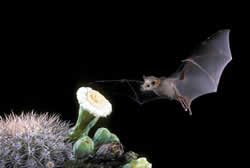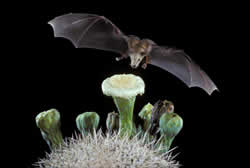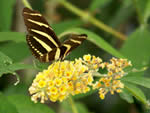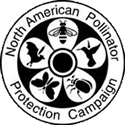USDA Forest Service Celebrating Wildflowers
|
|
|
Lesser Long-Nosed BatBy Kim Winter During late spring in the Sonoran Desert, the white flowers of Saguaro (Carnegiea gigantea) cacti bloom for just one evening to attract Lesser Long-nosed Bats (Leptonycteris curasoae yerbabuena) and Mexican Long-tongued Bats (Choeronycteris mexicana) for pollination. The bats use their elongated muzzles to reach deep into Saguaro blossoms for nectar, covering their hairy heads with copious amounts of pollen that drop onto other flowers as the bats fly from cactus to cactus throughout the night. The blossoms close by the following afternoon, allowing daytime visitors such as wasps, bees, butterflies, and birds to pick up any remaining nectar or pollen left behind. Lesser long-nosed bats are perfectly adapted to feed and pollinate Saguaros and other large Southwestern and Mexican succulents such as Organ-pipe Cactus (Stenocereus thurberi), agaves (Agave spp.) and Cardón (Pachycereus pringlei). Their narrow snouts easily detect the strong melon scent of the night-blooming flowers, and their brush-tipped tongues extend deeply into flowers to extract rich quantities of nectar and pollen produced by the cacti to ensure that pollinators will find them during their brief period of bloom. Bat pollination of cacti and agaves helps maintain healthy desert ecosystems. Saguaros, the state flower of Arizona, are keystone species in the Sonoran Desert and grow up to 50 feet in height, providing important perching and nesting sites for Red-tailed Hawks (Buteo jamaicensis); and nesting cavities for Gilded Flickers (Colaptes chrysoides) and Gila Woodpeckers (Melanerpes uropygialis), Elf Owls (Micrathene whitneyi), Purple Martins (Progne subis), and other birds. Once the Saguaro fruit ripens in June, Lesser Long-nosed Bats, White-winged Doves (Zenaida asiatica), Gila Woodpeckers, and other birds consume the fleshy red pulp and thereby disperse the seeds, which pass through their guts intact. Agaves provide an important food resource to the Lesser Long-nosed Bat during its annual migration from Mexico to the Sonoran Desert. The Lesser Long-nosed Bat is federally listed as endangered species by the U.S. Fish and Wildlife Service under the Endangered Species Act of 1973. The survival of both bats and their desert food plants are threatened by loss of habitat due to development, invasive annual grasses, and changes in fire regimes. With nature in the balance, ensuring the future of the southwestern desert will depend on appreciating and protecting the roles played by both pollinator and plant in these fragile ecosystems. For additional information
|
|
| NOTE: PDF format links require the Adobe Acrobat Reader to view. | |
| top | Disclaimers | FOIA | Privacy Policy | Quality of Information | Photo Credits & Use |
Location: http://www.fs.fed.us/wildflowers/pollinators/pollinator-of-the-month/lesser_long-nosed_bat.shtml
Last modified: Tuesday, 20-May-2008 15:56:00 EDT



